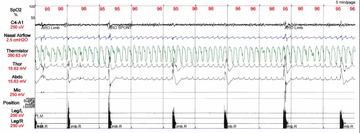Periodic limb movement disorder
| Periodic limb movement disorder | |
|---|---|
| Classification and external resources | |
| Specialty | neurology |
| ICD-10 | G47.8 |
| ICD-9-CM | 327.51 |
| DiseasesDB | 36388 |
| MeSH | D009207 |
Periodic limb movement disorder (PLMD), previously known as nocturnal myoclonus, is a sleep disorder where the patient moves limbs involuntarily during sleep, and has symptoms or problems related to the movement.
PLMD should not be confused with restless legs syndrome (RLS). RLS occurs while awake as well as when asleep, and when awake, there is a voluntary response to an uncomfortable feeling in the legs. PLMD on the other hand is involuntary, and the patient is often unaware of these movements altogether.
Symptoms
Patients with PLMD will complain of excessive daytime sleepiness (EDS), falling asleep during the day, trouble falling asleep at night, and difficulty staying asleep throughout the night. Patients also display involuntary limb movements that occur at periodic intervals anywhere from 20–40 seconds apart. They often only last the first half of the night during non-REM sleep stages. Movements do not occur during REM because of muscle atonia.
Diagnosis

People with PLMD often do not know the cause of their excessive daytime sleepiness and their limb movements are reported by a spouse or sleep partner. PLMD is diagnosed with the aid of a polysomnogram or PSG. PLMD is diagnosed by first finding PLMS (periodic limb movements of sleep) on a PSG, then integrating that information with a detailed history from the patient and/or bed partner. PLMS can range from a small amount of movement in the ankles and toes, to wild flailing of all four limbs. These movements, which are more common in the legs than arms, occur for between 0.5 and 5 seconds, recurring at intervals of 5 to 90 seconds. A formal diagnosis of PLMS requires three periods during the night, lasting from a few minutes to an hour or more, each containing at least 30 movements followed by partial arousal or awakening.
Causes
It is mostly unknown what causes PLMD, but in many cases the patient also suffers from other medical problems such as Parkinson's disease or narcolepsy. Factors that increase the likelihood of PLMD in the absence of restless leg syndrome include being a shift worker, snoring, coffee drinking, stress, and use of hypnotics, particularly in the case of benzodiazepine withdrawal. For women, the presence of musculoskeletal disease, heart disease, obstructive sleep apnea, cataplexy, doing physical activities close to bedtime and the presence of a mental disorder were significantly associated with having a higher risk of both PLMD and restless legs syndrome.[1]
Epidemiology
PLMD is estimated to occur in approximately 4% of adults (aged 15–100),[1] but is more common in the elderly, especially females, with up to 11% experiencing symptoms.[2] PLMD appears to be related to restless legs syndrome (RLS) - a study of 133 people found that 80% of those with RLS also had PLMD.[3] However the opposite is not true: many people who have PLMD do not also have restless legs syndrome.
Treatment
PLMD is often treated with anti-Parkinson medication; it may also respond to anticonvulsants, benzodiazepines, and narcotics. Patients must stay on these medications in order to experience relief, because there is no known cure for this disorder. PLMs tend to be exacerbated by tricyclic antidepressants, SSRIs, stress, and sleep deprivation. It is also advised not to consume caffeine, alcohol, or antidepressants as these substances could worsen the PLMD symptoms.
Other medications aimed at reducing or eliminating the leg jerks or the arousals can be prescribed. Non-ergot derived dopaminergic drugs (pramipexole and ropinirole) are preferred.[4] Other dopaminergic agents such as co-careldopa, co-beneldopa, pergolide, or lisuride may also be used. These drugs decrease or eliminate both the leg jerks and the arousals. These medications are also successful for the treatment of restless legs syndrome.
In one study, co-careldopa was superior to dextropropoxyphene in decreasing the number of leg kicks and the number of arousals per hour of sleep. However, co-careldopa and, to a lesser extent, pergolide may shift the leg movements from the nighttime to the daytime.[5] Clonazepam, (Klonopin), in doses of 1 mg has been shown to improve objective and subjective measures of sleep.[6]
See also
References
- 1 2 J Psychosom Res. 2002 Jul;53(1):547-54. It is more commonly reported in the elderly and those with the previous medical conditions stated earlier. PLMD can cause insomnia and daytime sleepiness. Prevalence of restless legs syndrome and periodic limb movement disorder in the general population. Ohayon MM, Roth T.
- ↑ J Psychosom Res. 2004 May;56(5):543-8. Restless legs syndrome and periodic limb movement disorder in the elderly. Hornyak M, Trenkwalder C.
- ↑ Clinical, polysomnographic, and genetic characteristics of restless legs syndrome: a study of 133 … J Montplaisir, S Boucher, G Poirier, G Lavigne, O … - Mov Disord, 1997
- ↑ "Periodic Limb Movements in Sleep". Armenian Health Network, Health.am. Sep 21, 2006. Retrieved 2009-07-15.
- ↑ Kaplan PW, Allen RP, Buchholz DW, Walters JK. A double-blind, placebo-controlled study of the treatment of periodic limb movements in sleep using carbidopa/levidopa and propoxyphene. Sleep. 1993;16(8):717-723.
- ↑ Restless legs syndrome (RLS) and periodic limb movement disorder (PLMD) Acute placebo-controlled sleep laboratory studies with clonazepam. European Neuropsychopharmacology , Volume 11 , Issue 2 , Pages 153 - 161. M . Saletu